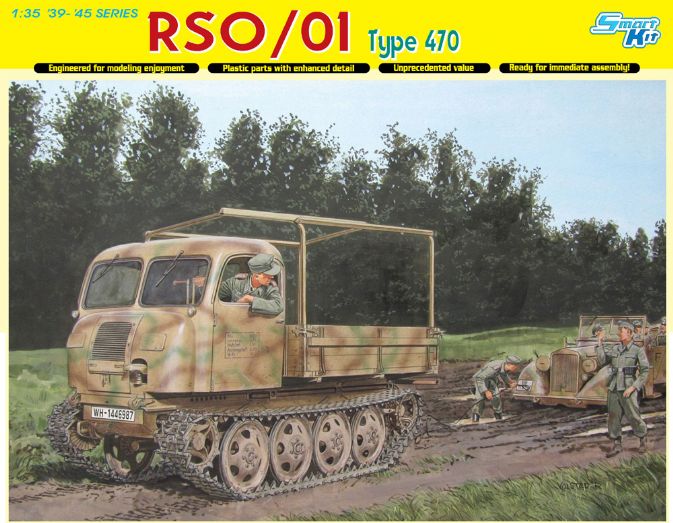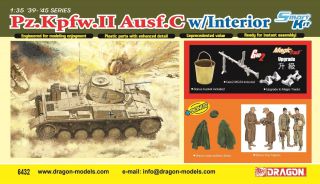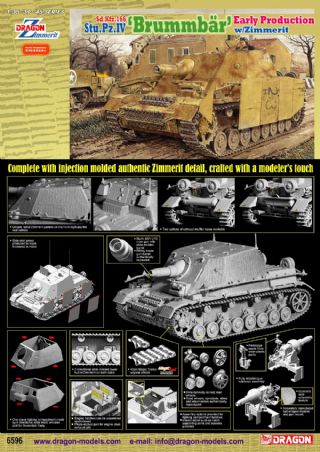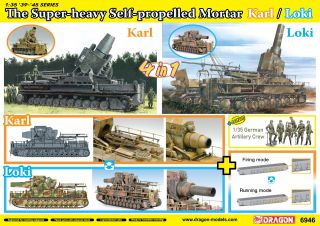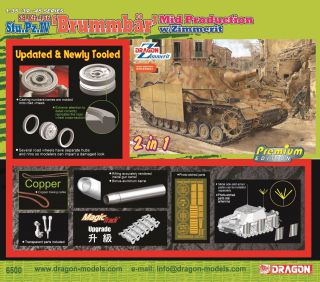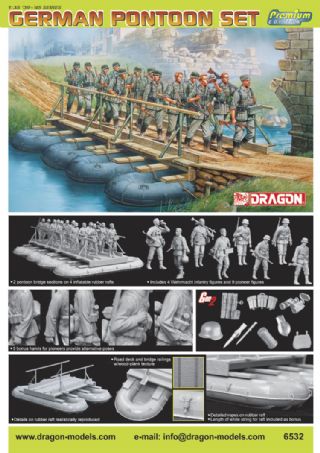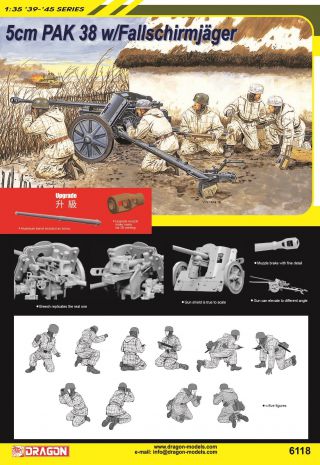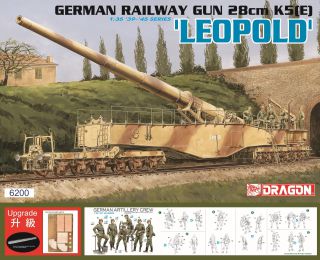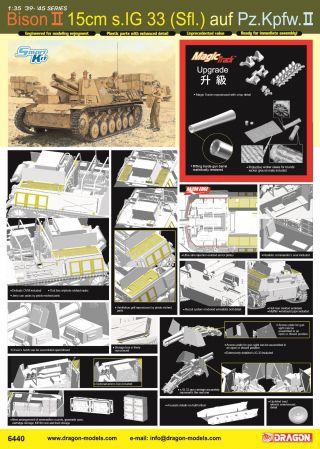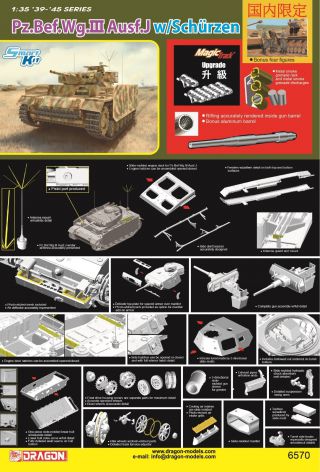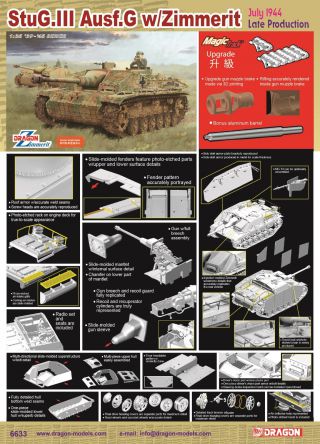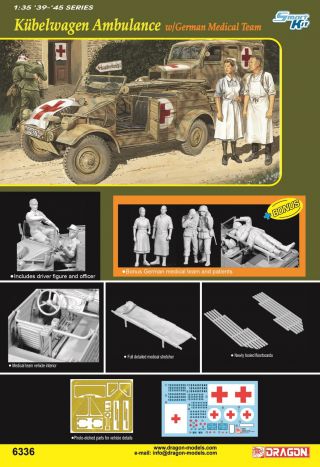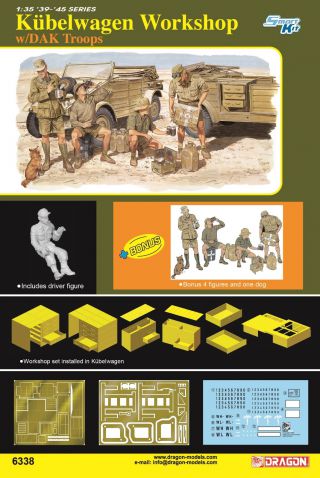HOME → Dragon Plastic Model Kits → 1/35 WWII Military → 6691


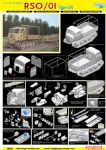
Box Size: 245 x 380 x 60mm
Packaging: 20 pieces per master carton
Bar Code: 0 89195 86691 2
Features:
- Newly tooled RSO rendered with fine detail
- Newly tooled cabin captures the complex shape accurately, produced using slide-mold technology
- Newly tooled levers and pedals for driver's compartment can be assembled in separate parts
- New dash board w/realistic detail
- Side panels and tailgate of brand new cargo deck can be shown folded up or down
- Delicate and realistic new engine provided
- Brand new Magic Track
- Curved frame on cargo compartment
- Spare Winterketten tracks w/detailed surfaces on side panels
- Cabin produced in separate parts for easy assembly
- Driver's door can be assembled open/closed
- Realistic seats included
- Delicate Notek lamp reproduced
- One-piece chassis and upper hull w/accurate thickness and details
- Accurate lower hull
- Fine pattern molded on hull bottom
- Drive sprocket and mountings accurately replicated
- Engine and transmission realistically reproduced
- Detailed suspension included
- Delicate raod wheels
- Separate road wheels w/photo-etched details mounted in pairs
- Ammo case is included
- Muffler w/exhaust pipe accurately produced
Dragon has already introduced later variants of the RSO to the modeling fraternity in 1/35 scale, but now comes the most common version of this German prime mover. The acronym RSO stands for Raupenschlepper Ost, which translates as "Caterpillar Tractor East". The terrible muddy and icy conditions experienced on the Eastern Front convinced Germany of the need for a highly mobile, tracked vehicle. Steyr proposed the RSO and it immediately became a popular vehicle thanks to its mobility and reliability. In all, about 23,000 RSO vehicles were produced by a range of manufacturers. The original version had a pressed-steel cab and a typical truck-style cargo bed at the rear. It was powered by a Steyr 85hp V8 engine that offered a top speed of 30km/h.
Dragon's new 1/35 scale model depicts the standard RSO/01, this type with rounded steel cab being the best known of all the versions used by Germany. Indeed, the complex shape of the cab was created by a Japanese model-maker, and it is easily the most accurate cab available on the market today. The cab is a sophisticated piece of molding in terms of detail and measurements, with all the curves accurately reproduced in miniature. Many modelers have been waiting a long time for Dragon to produce this iconic version of the RSO, and they won't be disappointed with this new kit. For those wishing to create a dynamic Eastern Front diorama scene, this RSO tractor will prove irresistible!
Reviews:
RSO/01 Type 470
Manufacturer: Dragon Models
Scale: 1/35
Material: Styrene & Photo-etch
Serial Number: 6691
Price: TBA
Dragon:
The acronym RSO stands for Raupenschlepper Ost, which translates as 'Caterpillar
Tractor East'. The terrible muddy and icy conditions experienced on the Eastern
Front convinced Germany of the need for a highly mobile, tracked vehicle. Steyr
proposed the RSO and it immediately became a popular vehicle thanks to its mobility
and reliability. In all, about 23,000 RSO vehicles were produced by a range
of manufacturers. The original version had a pressed-steel cab and a typical
truck-style cargo bed at the rear. It was powered by a Steyr 85hp V8 engine
that offered a top speed of 30km/h. This kit depicts the standard RSO/01, the
type with rounded steel cab being the best known of all the versions used by
Germany.
Kit Contents
This is the one I've been waiting for! I suspect a lot of modellers feel the same too. The previously released two version of this vehicle were nice....but this one's great! Anyway, I'm getting ahead a little. The kit contains many sprues of grey styrene. If absolutely must know how many parts then look on the Dragon website. If you absolutely must know how many sprues...seek help. In addition to all the sprues, there are two small photo-etched brass frets, a decal sheet, a small transparent sprue, and a bag of individual 'Magic Track' track links. The instructions run to eight sides...which is nearly as many as nine! If fact...it's more than seven!
The parts are all moulded to exceptional standard, as you would expect from
this manufacturer in a brand new kit. No flash. The very idea! No ejector pin
marks either...Dragon don't do them. There are actually quite a few parts marked
as 'not for use', which is as a result of the previous two releases. Remember
it is a tiny vehicle, only measuring approximately 12 cm when complete.
The brand new very characteristic pressed steel front cab of the vehicle is
provided as a one-piece moulding. That's the part that everybody was waiting
for! The rest is the same. Seriously. Well...nearly anyway. The point is....the
one with the front like a milk float, is the one we all wanted. It just looks
so....like a milk float.
As a result of the new cab front of course, we have a new cab rear. Otherwise it wouldn't fit. This necessitates two new sides, and all the bits that go inside. So we're given new dashboard, pedals, seats etc. The seats in this version are more than the simple padded shapes offered in the earlier releases. This version consists of the tubular frame ones with padded cushions over the frame. The separate pressed steel doors also have inner skins that represent the pattern of the strengthening ribs etc., and clear acetate is trapped between the inner and outer panels to represent the glazing. Full masks are provided for all the glazing, including the windscreen, but these are only supplied for the outside, therefore plan your painting carefully, or produce your own masks for inside the cab.
We're also supplied with a brand new engine moulding, in the form of a petrol Styr V8 cylinder, necessitated by the Diesel engine represented in the previously released kits. It's a very different looking engine, and the kit parts that go to making it are also engineered in a completely different way. The drive train is somewhat different too, consisting of an automotive type differential, rather than the later Cletrac-type in the other kits. The chassis of the vehicle is still constructed in a similar manner, consisting of a one piece ladder chassis, onto which two length-wise inserts are added to provide the requisite detail, and then the various drive train components and engine are added.
The suspension and running gear are constructed in a similar manner too, and
this means that it's actually quite difficult to get everything lines up nice
and square, so study the instructions carefully, and try to cement anything
into a fixed position before later in the construction. The tracks are of the
individual 'Magic Track' type, and are not workable. Each link is free from
ejector pin marks, although there is a tiny pip on the inner surface of each
that some modellers will decided they have to remove.
The rear cargo bed is similar to the other two versions, i.e. wood, side and
end panel can be raised or lowered, and there are photo-etched details in the
form of latches. There's a tilt frame supplied that can be fitted according
to choice (or references), and we're still supplied with a partial set of Winterketten
tracks that can be held in racks along each side of the cargo bed.
There are seven marking/colour schemes illustrated on the instructions leaflet,
only one in plain dark yellow, and one in panzer grey...all the others are various
camouflage schemes and include a winter whitewashed one. See below for full
details.
Conclusion
Definitely a thoroughbred. It's the one most modeller's have been waiting for....and it's ben worth the wait. Superb engineering, superb detail. Highly recommended.
- Vinnie Branigan
Kit Review: Dragon Models Limited 1/35 scale '39-'45 Series Kit No. 6691; RSO/1
Type 470 - Smart Kit; 506 parts (305 in grey styrene, 144 "Magic Track"
single links, 50 etched brass, 7 clear styrene); pre-order price US$48.95 via
Dragon USA Online
Advantages: essentially completes the series of RSO chassis; many new parts
from first two releases; thorough chassis detailingd
Disadvantages: single link tracks very small; snow tracks add to complexity
Rating: Highly Recommended
Recommendation: for all German WWII "Ostfront" fans
Anyone who went to the 2012 AMPS International Show at the Kruse Victory Museum
in Auburn, Indiana, most likely looked at the 130 odd 1/1 scale vehicles on
display. One thing that was notable was the fact that the museum had one each
of the major versions of the Steyr RSO tracked prime mover and carrier. Now
DML has matched them with their own new kit of the RSO/1 Typ 470 with pressed
steel cab.
Old hands will recognize this version as the one modeled over 35 years ago by
Peerless Max. While the conversions have generally been more popular with modelers
over the years, this was the original cargo carrier and light prime mover which
the Germans adopted (and nicknamed "Austria's Revenge" for its nasty
riding habits).
Once again DML has redone or reworked the original two kits. The lovely little
49 piece air-cooled V-8 engine has returned in this, and another
Quite a bit has changed. The original kit came with a 49 part air cooled eight-cylinder
diesel engine as well as more than 50 parts to the new steel cab. But you will
have to leave the cab loose to display any of that detail, or leave the doors
open and leave out the three-section engine access cover (parts H10/11/12).
As before assembly is straightforward. The chassis takes the first eight steps
of the instructions (once again, as this is a small and "clean" vehicle
the directions are easier to read than many DML efforts).
The running gear is simple but nicely done, with the bogie mount and springs
as separate parts. The entire lower running gear forms one giant bogie assembly
when done. There is a lower chassis pan all of this mounts on and it comes with
separate frame risers and crossbars. Note that the drivers and idlers on an
RSO are nearly interchangeable so you must keep them straight during installation.
The steel cab comes with three-piece seats – "lawn chair" type slat
frames and a pad which attaches to the assembled frames. The doors each consist
of inner and outer halves and external handles plus window inserts. All of the
primary controls are provided.
The body (the same as the RSO/3) is typical for open bodied cargo vehicles and
also gives several options, including folded sides and either metal or wooden
top bows for the canvas. Racks are provided from either styrene or etched brass
for stowing the snow track links on the body sides.
The latter items are apparently only for "show" as the directions
simply show where they are stowed (the "bin" from the RSO/3 is now
missing, however) with 10 on each side of the cargo body). But these are just
the plates and need only attachment, not assembly. and are assembled – three
parts to each one. But installation is not covered very well, with the directions
seemingly saying the side stowed plates store cleats out with wooden frames.
But once again DML shows the "Magic Tracks" assembled (67 links per
side) and simply slipped onto the running gear. Not gonna happen. Most modelers
know there are many ways to skin this mule but this is NOT one of them without
DS plastic one-piece tracks.
Tom Cockle and Gary Edmundson are cited as the consultants for this kit.
Finishing information is provided for seven different vehicles: Unidentified
Unit, Eastern Front 1944 (sand with brown/green overspray, WH-1446987); 1st
Skijaeger Division, Eastern Front 1944 (white over sand, WH-1500128); Unidentified
Unit, 1942 (grey with tactical marking); 19th Volksgrenadier Division, Western
Front 1944/45 (sand with green/brown dot pattern, no registration number); Unidentified
Unit, Eastern Front 1943 (green over sand, shipping stencils, no registration
number); Unidentified Unit, Eastern Front 1943 (sand, shipping stencils, WH-1446645);
Unidentified Unit, Eastern Front 1943 (green over sand, white Mu, no registration
number). A sheet of Cartograf decals with a "number jungle" is provided
for the RSO.
Overall this completes the basic "set" of RSO vehicles and is a contemporary
design and production quality kit.
- Cookie Sewell
DR6691: RSO/01 Type 470
1/35 injection plastic kit with PE, accessories and decals
In 1942 the first RSO (Raupenschlepper Ost) were used by the German Army on
the Eastern Front. Built by Steyr based on one of their light trucks, this fully
tracked tractor was well suited to hauling artillery and general supplies in
the snow and mud. The front line troops liked the RSO and production was soon
expanded by bringing in other assembly firms. Steyr assembled around 2,600 RSOs.
This new release from Dragon depicts the original Steyr RSO/01. It was distinguished
by the fully enclosed pressed steel cab and its Steyr designed V8 petrol engine.
This is Dragon’s first release of the RSO/01 and has many new parts including
the cabin body and interior, engine and frame over the cargo bay. Dragon’s previous
cargo version (kit 6684) was the later production RSO/3 that had a Deutz diesel
engine and a simplified driver’s cab which was built largely from flat metal
panels with a canvas roof.
This new RSO/01 features Magic Tracks and two PEs One fret has for the hinges
and other detail on the platform’s drop sides, centre detail on the road wheels
and the ends of the suspension struts. The smaller fret has a cover to protect
the front transmission axle. It has separate parts for the inspection flap and
sides.
The gatefold instructions have 13 steps of line drawings. Initial examination,
the absence of visible sink marks, and experience with Dragon’s previous RSOs,
suggests that this kit fits together nicely.
NEW CAB & PLATFORM
The cab and its interior are new tooling for the earlier truck like pressed
steel roof. This kit includes a detailed driving compartment with new control
levers, foot pedals, dash board, and three part front seats. Between the seats
is a new large cover over the engine.
The exterior sheet metal nicely captures the pressed steel cabin and its many
curved panels which hint at the RSO’s truck origins. These panels differentiate
it from the later RSO/3. There is a crisp Notek light mounted in a recess on
the front. The doors are built with separate parts for the inner lining to provide
detail on both sides, the inner panels having quite distinctive pressed recesses.
The front windscreen, side glass and rear glass panels are clear plastic. This
kit has separate parts for the windscreen wipers (good for painting) and door
handles.
You have the option of three one piece louvers on the front of the cab. The
choice is fully shut, half open and fully open (the instruction sheet does not
show part 34 which is half open). If the open louvers are used you will be able
to glance at the engine behind them.
This RSO has an open cargo platform with wooden drop sides. The sides can be
modeled up or down, have detail on both faces and are free of sink marks. PE
and plastic detail captures the hinges, latches and bracing. An open frame sits
above the platform (no cover included, but a stowed cover can be easily made
from metal foil such as that found on wine bottles). The selective use of PE
gives this cargo bay a refined in scale appearance.
Both drop sides have racks for stowing spare winter tracks. The racks each have
a PE cross rail and the tracks are plastic with no visible sink marks. Not all
RSO carried spare tracks, so the option is yours.
The cargo platform is connected to the chassis by three cross beams.
REVISED RUNNING CHASSIS
This kit has a running chassis specific to the RSO/01 and hence has many new
chassis parts including the Steyr V8 engine.
The lower hull is based around a detailed one-piece tub, which includes detail
on the belly. The hull is then built up by adding separate upper side plates
(and some cross members and other fittings such as front tow hooks. A rear towing
point/pintle is mounted on a towing frame. The muffler which has hollowed exhaust
pipe is crisply tooled and has small PE parts for fine detail.
Fitted onto the chassis is a newly tooled Steyr petrol engine which has separate
parts for the pump, filter, manifolds, fan belt, mountings, crankshaft etc.
Attached to the engine is the transmission shaft which has realistic detail
for the joints and runs to the drive sprockets which have al the workings of
the new gear box behind them. A rib braced plate sits above the shaft.
The eight road cast wheels (four per side) are detailed on both faces (e.g.
bolt heads and rims) and have PE detail over the hubs as well as on the ends
of suspension arms. The pre-cut Magic Tracks capture the sag typical of the
RSO’s tracks nicely and are, in my view, the right tracks to include.
PAINT SCHEME & DECALS
The instruction sheet and the color plates on the box, profile seven RSO with
a variety of paint schemes typical of those seen in wartime photos. The waterslide
decal sheet includes unit and tactical markings, shipping stencils and three
sets of targeted registration plates. The sheet also includes generic decals
to build your own registrations for both Wehrmacht and Waffen SS (split runes).
The RSO are:
- * Unidentified Wehrmacht unit on the Eastern Front 1944 which is dark yellow with red-brown and green camouflage stripes (box art)
- * 1 Ski Jaeger Division on the Eastern Front 1944 which is white washed with unit emblems.
- * Unidentified unit on the Eastern Front 1942 which is solid dark grey.
- * 19 Volksgrenadier Division on the Eastern Front 1944 Western Front 1944/45 which has green camouflage spots..
- * Unidentified unit on the Eastern Front 1943 which is dark yellow with limited green camouflage.
- * Unidentified unit on the Eastern Front 1943 which is dark yellow.
- * Unidentified unit on the Eastern Front 1943 which is dark yellow with patches of green camouflage and white 'Mu' on the cab doors.
RECOMMENDATION
The RSO /01 has plenty of potential for modelers and I am pleased to see this
release join Dragon's range. The combination of crisp tooling, good part fit,
and that the Steyr designed RSO/01 was widely used on the front line means this
kit should be popular. Definitely recommended.
- Neville Lord

